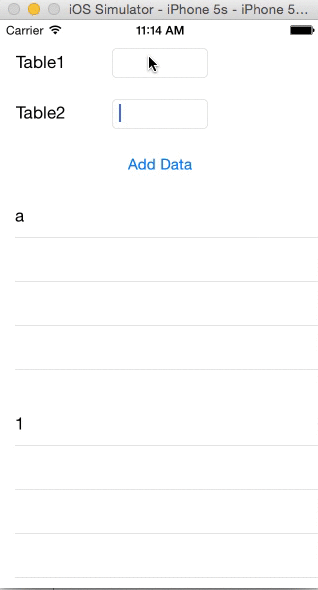SwiftのUITableViewに新しいセルを挿入する方法
私は2つのUITableViewsと2つのUITextFieldsがあるプロジェクトに取り組んでいます。ユーザーがボタンを押すと、最初のtextFieldのデータはtableViewに入り、2番目はtableViewに入ります。私の問題は、ユーザーがボタンを押すたびにtableViewにデータを配置する方法がわからないことです。tableView:cellForRowAtIndexPath:を使用してデータを挿入する方法を知っていますが、それは私の知る限り一度だけ機能します。では、ユーザーがボタンを押すたびにtableViewを更新するためにどのような方法を使用できますか?
beginUpdatesおよびendUpdatesを使用して、ボタンがクリックされたときに新しいセルを挿入します。
まず、TableView配列にデータを追加します
Yourarray.append([labeltext])
次に、テーブルを更新して新しい行を挿入します
// Update Table Data
tblname.beginUpdates()
tblname.insertRowsAtIndexPaths([
NSIndexPath(forRow: Yourarray.count-1, inSection: 0)], withRowAnimation: .Automatic)
tblname.endUpdates()
これによりセルが挿入され、テーブル全体を再ロードする必要はありませんが、これで問題が発生した場合は、tableview.reloadData()も使用できます
Swift 3.
tableView.beginUpdates()
tableView.insertRows(at: [IndexPath(row: yourArray.count-1, section: 0)], with: .automatic)
tableView.endUpdates()
Objective-C
[self.tblname beginUpdates];
NSArray *arr = [NSArray arrayWithObject:[NSIndexPath indexPathForRow:Yourarray.count-1 inSection:0]];
[self.tblname insertRowsAtIndexPaths:arr withRowAnimation:UITableViewRowAnimationAutomatic];
[self.tblname endUpdates];
両方のtableViewにデータを追加するためのコードは次のとおりです。
import UIKit
class ViewController: UIViewController, UITableViewDelegate, UITableViewDataSource {
@IBOutlet weak var table1Text: UITextField!
@IBOutlet weak var table2Text: UITextField!
@IBOutlet weak var table1: UITableView!
@IBOutlet weak var table2: UITableView!
var table1Data = ["a"]
var table2Data = ["1"]
override func viewDidLoad() {
super.viewDidLoad()
}
@IBAction func addData(sender: AnyObject) {
//add your data into tables array from textField
table1Data.append(table1Text.text)
table2Data.append(table2Text.text)
dispatch_async(dispatch_get_main_queue(), { () -> Void in
//reload your tableView
self.table1.reloadData()
self.table2.reloadData()
})
table1Text.resignFirstResponder()
table2Text.resignFirstResponder()
}
//delegate methods
func numberOfSectionsInTableView(tableView: UITableView) -> Int {
return 1
}
func tableView(tableView: UITableView, numberOfRowsInSection section: Int) -> Int {
if tableView == table1 {
return table1Data.count
}else if tableView == table2 {
return table2Data.count
}
return Int()
}
func tableView(tableView: UITableView, cellForRowAtIndexPath indexPath: NSIndexPath) -> UITableViewCell {
if tableView == table1 {
let cell = table1.dequeueReusableCellWithIdentifier("Cell", forIndexPath: indexPath) as! UITableViewCell
let row = indexPath.row
cell.textLabel?.text = table1Data[row]
return cell
}else if tableView == table2 {
let cell = table2.dequeueReusableCellWithIdentifier("Cell1", forIndexPath: indexPath) as! UITableViewCell
let row = indexPath.row
cell.textLabel?.text = table2Data[row]
return cell
}
return UITableViewCell()
}
}
結果は次のようになります。
Swift 3.0ソリューションを更新
下に挿入
self.yourArray.append(msg)
self.tblView.beginUpdates()
self.tblView.insertRows(at: [IndexPath.init(row: self.yourArray.count-1, section: 0)], with: .automatic)
self.tblView.endUpdates()
TableViewの上部に挿入
self.yourArray.insert(msg, at: 0)
self.tblView.beginUpdates()
self.tblView.insertRows(at: [IndexPath.init(row: 0, section: 0)], with: .automatic)
self.tblView.endUpdates()
